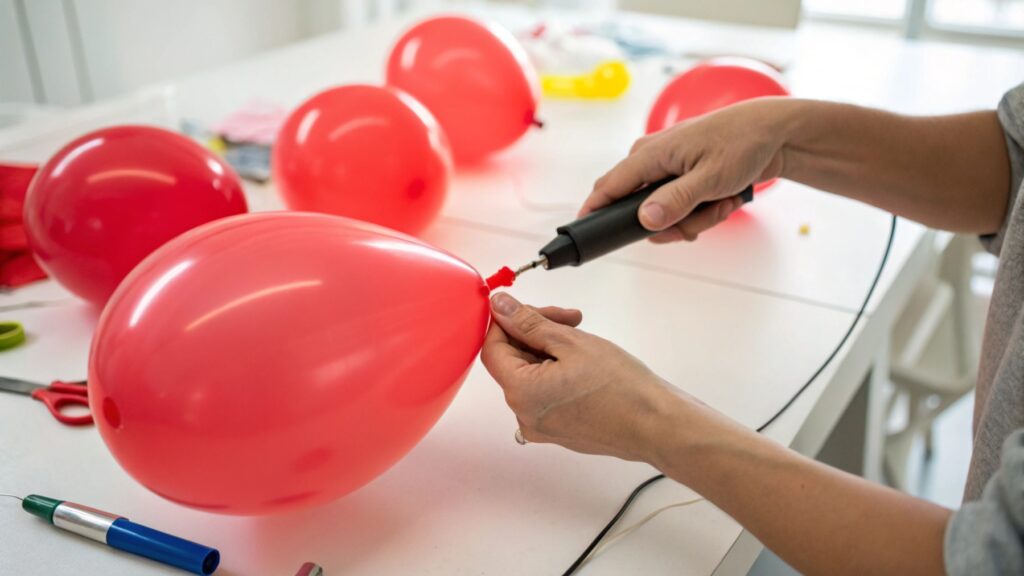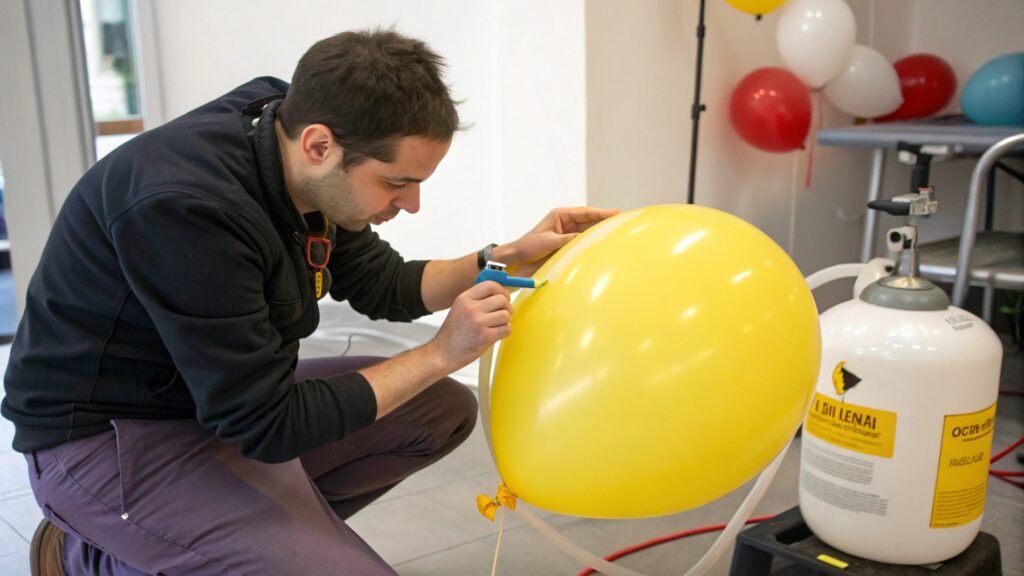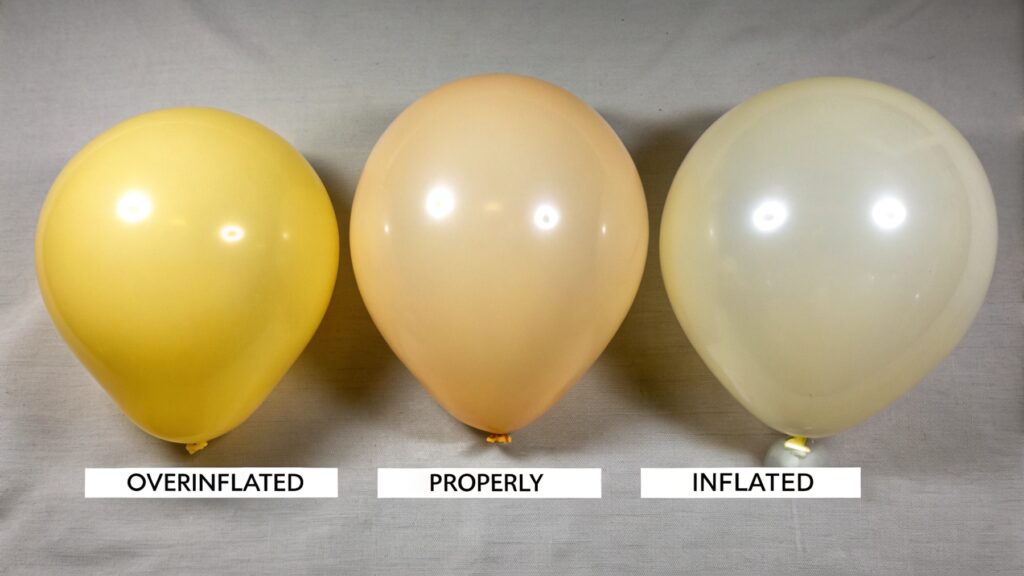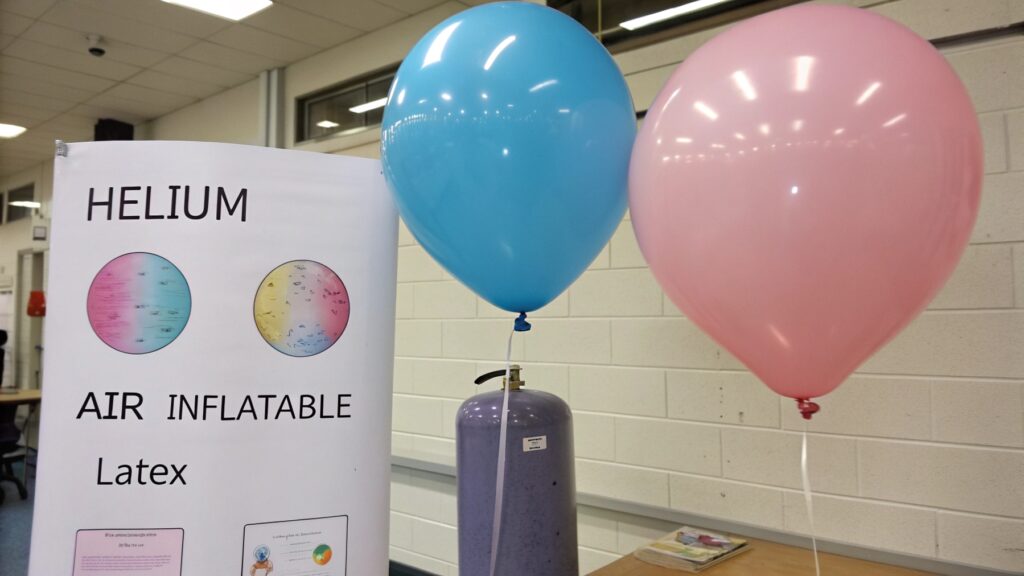How do inflation methods affect the lifespan of latex balloons?
Balloons add joy to any event, but a deflated balloon can ruin the fun. Do you know how your inflation choices1 impact how long your latex balloons last?
The way you inflate a latex balloon directly affects its lifespan. Proper inflation techniques, choosing the right gas, and avoiding extreme environmental factors are key to maximizing how long your balloons stay vibrant2 and floating.

I’ve spent years in the balloon industry, and I’ve seen firsthand how crucial the inflation process3 is. If you want your balloons to make moments colorful for longer, let's explore the best ways to inflate them.
What are the best inflation methods4 for maximizing latex balloon lifespan?
Are you wondering how to make your latex balloons last longer after inflation? The method you use truly matters.
The best inflation methods for maximizing latex balloon lifespan involve slow and controlled filling, avoiding sudden bursts of air, and ensuring the balloon is filled to its optimal size without overstretching the latex.

From my experience, one common mistake is rushing the inflation process. This can stress the latex and create weak points. We always teach our team to go slow and steady. Another factor is the quality of the balloon itself. At AIHUA BALLOON, we focus on producing balloons with consistent wall thickness and elasticity. This helps them withstand the inflation process better.
What are the techniques for optimal inflation?
To get the most out of your balloons, follow these simple but effective steps:
- Slow and Steady Inflation:
- Why it matters: Rapid inflation can cause uneven stretching and weaken the latex. Think of it like blowing up a bubble gum bubble too fast; it pops.
- How to do it: Use a regulator on your helium tank or a controlled pump for air. Fill the balloon gradually, allowing the latex to expand evenly.
- Correct Sizing:
- Why it matters: Inflating to the correct size, often slightly less than the maximum recommended, prevents overstretching. Overstretching thins the latex, making it more porous and prone to deflation.
- How to do it: Many professional inflators have sizers or templates. If not, inflate until the balloon is firm but still has a slight give when gently squeezed. Avoid filling until it looks like it will burst.
- Sealing and Tying:
- Why it matters: A good knot or seal is just as important as the inflation itself. A loose tie will let the gas escape quickly.
- How to do it: For air-filled balloons, use a heat sealer if applicable, or tie a tight double knot. For helium balloons, ensure the knot is secure and close to the balloon's neck.
| Inflation Method | Benefits for Lifespan | Considerations |
|---|---|---|
| Manual Pump | Good control over inflation speed | Can be tiring for many balloons |
| Electric Pump | Fast for air-filled, consistent pressure | Less control over speed if not regulated |
| Helium Tank | Provides float, requires regulator for control | Regulators are key for proper inflation |
How does overinflation or underinflation5 impact the durability of latex balloons?
Are you unsure if you are inflating your balloons too much or too little? Getting the inflation level right is crucial for durability.
Overinflation thins the latex, making balloons more prone to popping and faster gas leakage, while underinflation results in a saggy appearance and reduced float time, impacting durability and aesthetic appeal.

I have seen countless events where balloons either pop prematurely or look sad and droopy. It almost always comes down to incorrect inflation. From a manufacturing perspective, we design our balloons to have a certain elasticity. Pushing beyond that limit, or not reaching it, compromises the material.
What are the effects of incorrect inflation?
Understanding the precise effects of overinflation and underinflation can help you achieve the best results for your balloons:
- Overinflation:
- The Problem: When you overinflate, you stretch the latex beyond its optimal elasticity. The balloon's wall becomes thinner and more porous.
- Impact on Lifespan: This thinness makes the balloon more susceptible to punctures and stress. Gases, especially helium, can escape much faster through the stretched material. The balloon also becomes more rigid and less resilient to temperature changes, leading to premature popping or deflation. It's like stretching a rubber band too far; it loses its snap and eventually breaks.
- Underinflation:
- The Problem: Underinflation means the latex hasn't been stretched enough to create the internal pressure needed for a firm, round shape. The balloon looks saggy.
- Impact on Lifespan: While it might not pop, an underinflated balloon loses its aesthetic appeal quickly. For helium balloons, this means significantly reduced float time because there isn't enough lift to counteract the balloon's weight. The surface area is also reduced, which can affect the balloon's stability and how it holds its shape over time.
| Inflation State | Appearance | Primary Lifespan Impact | Risk Factors |
|---|---|---|---|
| Overinflated | Taut, sometimes pear-shaped | Rapid gas leakage, premature popping | Temperature sensitivity, punctures |
| Underinflated | Saggy, wrinkly | Reduced float time (helium), poor appearance | Less visual impact, quick deflation |
| Properly Inflated | Firm, round, smooth | Maximized float time, good durability | Minimal |
Which gases are recommended for inflating latex balloons to ensure a longer float time?
Are you trying to figure out which gas gives your latex balloons the longest float? The type of gas makes a big difference.
Helium is the recommended gas for inflating latex balloons to ensure a longer float time due to its lighter-than-air properties, allowing balloons to lift and remain airborne for extended periods compared to air.

In my experience, when customers ask for long-lasting balloons, my first question is always, "Are you using helium?" Air-filled balloons have their place, but for that magical floating effect, helium is the only way to go. We've optimized our latex formulations to work best with helium, ensuring minimal gas permeability.
Why is helium6 the best choice?
Choosing the right gas for your latex balloons is fundamental to their performance and longevity, especially if you want them to float.
- Helium:
- Properties: Helium is a noble gas, much lighter than the air we breathe (approximately 1/7th the density of air). This lower density is why helium balloons float. It also has very small atomic particles.
- Impact on Lifespan: Because it's so much lighter, a helium-filled balloon will float. However, helium's small atomic size means it can slowly permeate through the porous latex material. Even so, it provides the longest float time compared to other gases, typically lasting anywhere from 8 to 24 hours for standard latex balloons, depending on the balloon's size and quality.
- Recommended Use: Essential for any balloon display requiring lift and sustained floating.
- Air (Nitrogen and Oxygen Mix):
- Properties: Air is a mixture of gases, primarily nitrogen (about 78%) and oxygen (about 21%). It is denser than helium.
- Impact on Lifespan: Air-filled latex balloons will not float. They will hold their shape for a much longer period than helium-filled balloons, often weeks or even months indoors, because the larger air molecules do not escape through the latex as quickly as smaller helium molecules. The lifespan here refers to how long they remain inflated, not how long they float.
- Recommended Use: Ideal for balloon arches, columns, garlands, or any decoration that does not require floating.
| Gas Type | Property | Float? | Typical Lifespan (Inflated) | Typical Lifespan (Floating) |
|---|---|---|---|---|
| Helium | Lighter than air | Yes | 1-3 days (indoors) | 8-24 hours |
| Air | Denser than air | No | Weeks to months (indoors) | N/A |
Do environmental factors7 during inflation affect how long latex balloons last?
Are you wondering if the environment where you inflate your balloons matters? It absolutely does.
Environmental factors during inflation, such as temperature, humidity, and exposure to direct sunlight or sharp objects, significantly affect how long latex balloons last by influencing the integrity and permeability of the latex material.

I’ve seen balloons pop almost immediately after inflation just because they were handled in a very hot car. At AIHUA BALLOON, we emphasize to our clients that the storage and handling environment are just as important as the inflation process itself. A top-quality balloon can still fail if not treated properly.
How do environmental factors play a role?
The environment in which you inflate and display your latex balloons can profoundly impact their lifespan:
- Temperature:
- Impact: Extreme temperatures, both hot and cold, affect the latex. Heat causes the gas inside to expand, increasing internal pressure and making the balloon more likely to pop or deflate faster due to increased permeability. Cold temperatures cause the gas to contract, making the balloon appear deflated and potentially stressing the latex when it warms up again.
- Best Practice: Inflate and store balloons in a moderate, consistent temperature environment, ideally between 68-72°F (20-22°C).
- Humidity:
- Impact: High humidity can sometimes make latex balloons feel sticky and can slightly increase the rate of gas permeability over time, as water vapor molecules can also pass through the latex. Low humidity, especially when combined with high temperatures, can dry out the latex, making it brittle and more prone to popping.
- Best Practice: A moderate humidity level is best. Avoid extremely dry or excessively damp conditions.
- Direct Sunlight and UV Rays:
- Impact: UV rays from direct sunlight are detrimental to latex. They break down the material at a molecular level, causing the balloon to oxidize (become cloudy or dull) and weaken rapidly. This leads to faster deflation and popping.
- Best Practice: Always inflate and display latex balloons away from direct sunlight. If outdoor use is necessary, choose cooler, shaded areas, or opt for balloons treated with UV protectants.
- Sharp Objects and Rough Surfaces:
- Impact: This is perhaps the most obvious. Any contact with sharp edges, rough surfaces, or even dust and debris during inflation can create microscopic holes or weaken the latex, leading to immediate or rapid deflation.
- Best Practice: Ensure your inflation area is clean, smooth, and free of any sharp objects. Use clean hands and avoid dragging balloons across abrasive surfaces.
| Environmental Factor | Impact on Lifespan | Mitigation Strategy |
|---|---|---|
| High Temperature | Faster deflation, popping | Inflate in cool room, avoid direct sun |
| Low Temperature | Appears deflated, stress on latex | Allow to warm up gradually, inflate indoors |
| High Humidity | Stickiness, slightly faster permeability | Store in moderate humidity |
| Low Humidity | Brittle latex | Avoid very dry environments |
| Direct Sunlight | Oxidation, weakening, popping | Keep in shade, use UV-treated balloons |
| Sharp Objects | Punctures | Clean inflation area, careful handling |
Conclusion
Proper inflation methods, choosing helium for float, and controlling environmental factors are crucial for maximizing latex balloon lifespan. These steps ensure your balloons stay vibrant and make moments colorful for longer.
-
Understanding inflation choices can help you maximize the lifespan of your latex balloons, ensuring they stay vibrant and enjoyable for longer. ↩
-
Discover effective strategies to keep your balloons looking fresh and lively, enhancing the overall atmosphere of your event. ↩
-
Understanding the inflation process is key to maximizing the lifespan of your balloons. Explore this link for expert insights. ↩
-
Discover the most effective inflation methods to ensure your balloons stay inflated and colorful for longer. This link has valuable tips! ↩
-
Exploring the impacts of inflation levels can help you maintain balloon quality and appearance. ↩
-
Explore this link to understand why helium is essential for balloon displays and how it affects float time and longevity. ↩
-
Learn how temperature, humidity, and sunlight impact the lifespan of balloons, ensuring your displays last longer. ↩
